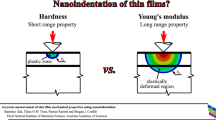Abstract
Anisotropy, usually orthotropy, arises in structural materials, particularly metals, due to production processes like laminations and concerns primarily parameters which govern the plastic behavior. Identification of such parameters is investigated here by a novel approach with the following features: experimental data provided by indentation curves only (not by imprint geometry); indenter shape with elliptical cross-section derived from classical conical or spherical shape and optimized by sensitivity analyses; indentation test repeated in near places after indenter rotation; deterministic inverse analyses centered on discrepancy function minimization and made computationally economical by an ‘a priori’ model reduction procedure.








Similar content being viewed by others
References
Tabor D (1951) The hardness of metals. Clarendon Press, Oxford
Mott BW (1957) Microindentation hardness testing. Butterworths, London
Bolzon G, Maier G, Panico M (2004) Material model calibration by indentation, imprint mapping and inverse analysis. Int J Solids Struct 41:2957–2975
Bocciarelli M, Bolzon G, Maier G (2005) Parameter identification in anisotropic elastoplasticity by indentation and imprint mapping. Mech Mater 37:855–868
Vlassak J, Nix WD (1994) Measuring the elastic properties of anisotropic materials by means of indentation experiments. J Mech Phys Solids 42:1223–1245
Jorgensen O, Giannakopoulos AE, Suresh S (1998) Spherical indentation of composite laminates with controlled gradients in elastic anisotropy. Int J Solids Struct 58:505–513
Swadener JG, Pharr GM (2001) Indentation of elastically anisotropic half-spaces by cones and parabolas of revolution. Philos Mag A 81:447–466
Vlassak J, Ciavarella M, Barber JR, Wang X (2003) The indentation modulus of elastically anisotropic materials for indenter of arbitrary shape. J Mech Phys Solids 51:1701–1721
Swadener JG, Rho J-Y, Pharr GM (2001) Effect of anisotropy on elastic moduli measured by nanoindentation in human tibial cortical bone. J Biomed Mater Res 57:108–112
Hengberger S, Enstoem J, Peyrin F, Zysset P (2003) How is the indentation modulus of bone related to its macroscopic elastic response? A validation study. J Biomech 36:1503–1509
Yonezu A, Kuwahara Y, Yoneda K, Hirakata H, Minoshima K (2009) Estimation of anisotropic plastic properties using single spherical indentation-an FEM study. Comput Mater Sci 47:611–619
Yonezu A, Tanaka M, Kusano R, Chen X (2013) Probing out-of-plane anisotropic plasticity using spherical indentation: a numerical approach. Comput Mater Sci 79:336–344
Nakamura T, Gu Y (2007) Identification of elastic-plastic anisotropic parameters using instrumented indentation and inverse analysis. Mech Mater 39:340–356
Bocciarelli M, Maier G (2007) Indentation and imprint mapping method for identification of residual stresses. Comput Mater Sci 39:381–392
Buljak V, Maier G (2012) Identification of residual stresses by instrumented elliptical indentation and inverse analysis. Mech Res Commun 41:21–29
Hill R (1948) A theory of yielding and plastic flow of anisotropic metals. Proc R Soc Lond A 193:281–297
Lubliner J (2008) Plasticity theory. Dover Publications, New York
Jirasek M, Bazant Z (2002) Inelastic Analysis of Structures. Wiley, London
Abaqus (2006) Standard, Theory and User’s manuals, Release 6.7, Simulia Inc., Providence, RI 02909, USA
Matlab (2002) User’s guide and optimization toolbox, release 6.13, The Math Works Inc., USA
Nocedal J, Wright SJ (2006) Numerical optimization. Springer, New York
Buljak V (2012) Inverse analysis with model reduction – Proper Orthogonal Decomposition in structural mechanics. Springer, Berlin
Jolliffe IT (1986) Principal component analysis. Springer, New York
Buljak V, Maier G (2011) Proper orthogonal decomposition and radial basis functions in material characterization based on instrumented indentation. Eng Struct 33:492–501
Kleiber M, Antunez H, Hien TD, Kowalczyk P (1997) Parameter sensitivity in non-linear mechanics. Willey, Chichester
Bui HD (1994) Inverse problems in the mechanics of materials: an introduction. CRC Press, Boca Raton
Tarantola A (2005) Inverse problem theory and methods for model parameter estimation. Society for industrial and Applied Mathematics, Philadelphia
Buhmann MD (2003) Radial basis functions. Cambridge University Press, Cambridge
Acknowledgments
Thanks are expressed by the authors to Tetrapak Company, Modena Factory, for support to Dr. V. Buljak during his research activity in Milan.
Author information
Authors and Affiliations
Corresponding author
Additional information
This paper is dedicated to Professor Piotr Perzyna, outstanding scientist in solid mechanics, who passed away last year.
Rights and permissions
About this article
Cite this article
Buljak, V., Bocciarelli, M. & Maier, G. Mechanical characterization of anisotropic elasto-plastic materials by indentation curves only. Meccanica 49, 1587–1599 (2014). https://doi.org/10.1007/s11012-014-9940-y
Received:
Accepted:
Published:
Issue Date:
DOI: https://doi.org/10.1007/s11012-014-9940-y




